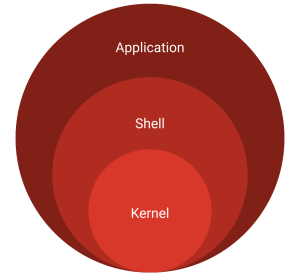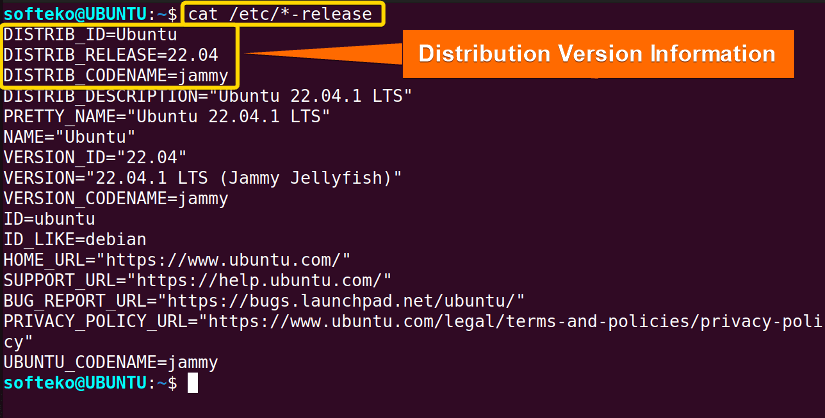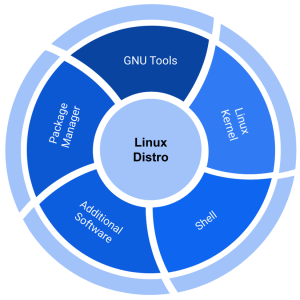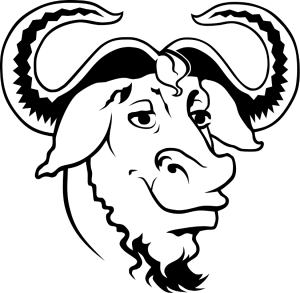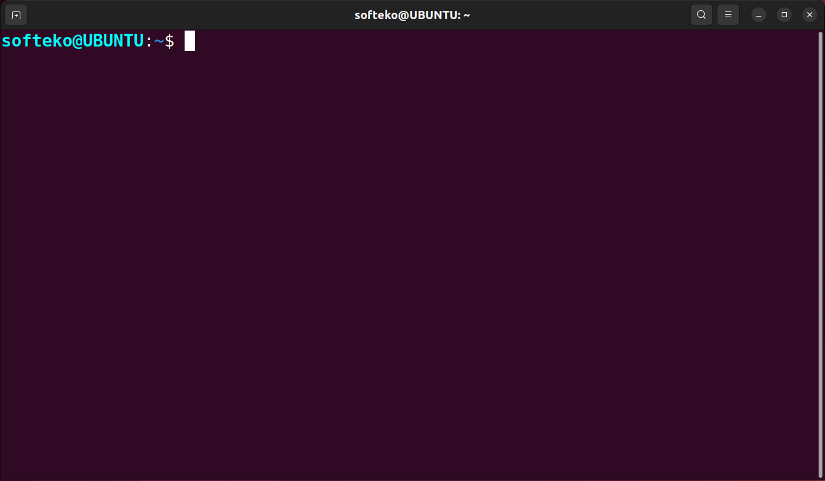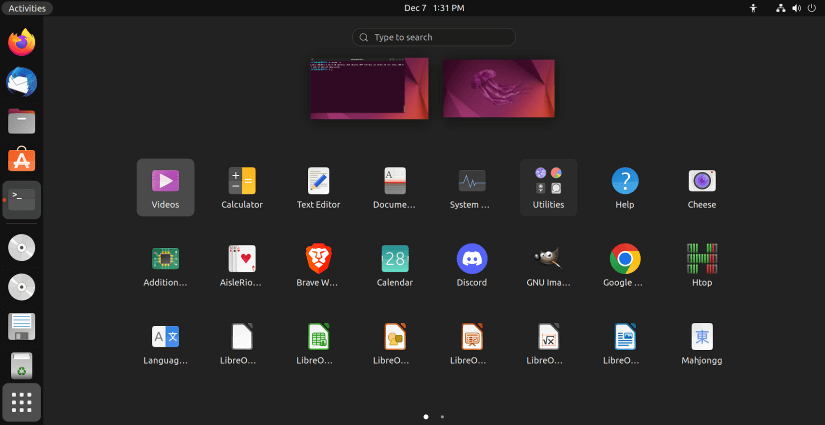FUNDAMENTALS A Complete Guide for Beginners

When people say Linux, they are referring to different distributions of Linux. A Linux Distribution has many common tools, but some are different and sometimes exclusive. In this article, you will look into the world of Linux Distribution and learn what makes them different.
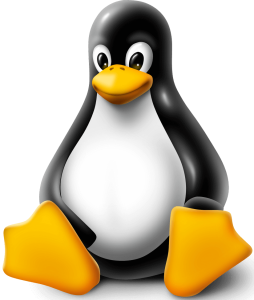
What is Distribution in Linux?
Linux distribution, also known as Linux distros, means a complete operating system with a Linux kernel, GNU tools and libraries, a package manager, a desktop environment, additional applications, and many more. Linux is a kernel which is the core component of an operating system. A complete operating system needs more than just a kernel. It requires a shell, package manager, application, and many different tools.
Linux was just a kernel integrated with the GNU software tools, and even many parts of the Linux kernel were built on GNU tools.
How Many Linux Distributions Are There?
There are over 600 Linux Distributions available. But many of them are slightly changed versions of the major ones. In the 600 distros, there must be included the discontinued ones and variations. The popular Linux distributions are Debian, Ubuntu, Fedora, RHEL, OpenSUSE, and Arch. Ubuntu is the most popular OS, with almost 34% of the market share.
Why Does Linux Have So Many Distributions?
Linux has many distributions because all the tools needed for developing the OS are free. All the tools and applications of Linux are open-source. This means a developer has the right to tweak any tools according to their needs. If a developer wants an OS customized for their own need, he can make one for himself.
Besides, Linux is used for many different purposes, from personal computers to large-scale servers. So it needs customization based on its purpose, and many distros were developed because of this.
What is the Distribution Version of Linux?
A distribution is built on top of many different tools. If you want to find out the Linux kernel version, you can use the following command.
uname -aOutput >
The output of this command will show you the current version of the Linux kernel of your system.
The Linux distribution has a version that you can find using the following command inside the Terminal.
cat /etc/*-releaseOutput >
You will find the following output with the necessary version information.
Components Distribution in Linux
There are many different components in a Linux Distribution. Here, you will learn about some of the significant components of a Linux Distribution.
A. GNU Tools
In 1983, the GNU project came to light with the contribution of Richard Stallman. He was the pioneer of the Free Software Movement. The result was the many different operating system tools that are FREE, as in Freedom. This means any developer can copy, move, edit or remove any part of the codes involved in that software.
Linux operating system uses many of these tools from the GNU project that made the Linux operating system truly open-source and free. Some of these tools are GCC (GNU Compiler Collection), GDB (GNU Debugger), GLIBC (GNU C Library), and many more.
All Linux distributions do not have the same set of GNU tools. However, many of them are common and essential, like the GCC.
B. Linux Kernel
Linux Kernel is a monolithic, Open-source, UNIX-like operating system kernel developed by Linux Torvalds in 1991. As the kernel is the core of an operating system that communicates with the hardware, it is an essential part of the software. Linux is a genuinely open-source kernel licensed under GNU general public license.
All Linux distributions have some version of the Linux kernel, and that’s what makes them Linux. You can update your distribution to a new version of the Linux kernel whenever you want.
C. Shell
Shell is the interconnect between the kernel and the software of an operating system. It is a text-based command interpreter that takes a command and sends it to the kernel to process the command.
There are many types of shells available in Linux. But in most Linux distributions, the default shell is called bash (bourne again shell). This name comes from a popular shell at that time that had the name Bourne Shell.
You can run any command in the shell, and in many instances, GUI-based software runs shell commands in the backend. It is an essential part of any Linux distribution.
D. Additional Software
Every distribution comes with some built-in software. Some of them are essential software like the GNU tools, but some are just additional software that is only sometimes essential but add to the user’s overall experience. Ubuntu, for example, comes with Mozilla Firefox and LibreOffice as the default internet browser and office tools. There are many more of this additional software included in a Linux distribution, which are not common.
E. Package Manager
In Linux, every distribution has a package manager. A package manager is a software that lets the user search, download, install, remove, and update any software or tools from remote repositories. In Ubuntu, for example, APT is the default package manager, a part of DPKG (Debian Package Management System). But there are also other package management systems like yum, pacman, dnf, etc.
Top 6 Most Used Distributions in Linux
A. Ubuntu
The distribution Ubuntu is one of the most popular Linux-based operating systems developed by canonical. Ubuntu belongs to the Debian-based Linux family, and many features, like the package manager, have similarities. Ubuntu had its first release in 2004, and the latest release is 23.10.
Here I will discuss some of the best features of Ubuntu:
- GUI: The distribution Ubuntu has one of the most user-friendly Graphical User Interfaces. It is based on GNOME (GNU Network Object Model Environment). So, It is effortless for a regular Windows user to switch to this distro than other distributions.
- Less Resource Required: Ubuntu is a lightweight operating system that can run on less powerful hardware. Nowadays, most of the other Linux distribution needs 4 GB of RAM. But this distro can run even on 512 MB RAM. It can also run with just a 700Mhz processor.
- Flavors: Ubuntu has many flavors and customizations. Canonical has many customizations of this distribution and release versions like Ubuntu Budgie, Xubuntu, etc.
B. Linux Mint
Linux Mint is based on Ubuntu with many customizations. The purpose of this distribution is to improve the experience. It shares all the advantages of Ubuntu and adds some more features. Here, you will find some of the features of Linux Mint.
- Less Memory Required: Linux Mint uses Cinnamon instead of GNOME for its Graphical Interface. Generally, Cinnamon is less resource-heavy and requires less memory.
- Software Manager: Ubuntu software manager is sometimes laggy, and updating software from the snap store is a hassle sometimes. However, the software manager on Linux Mint is relatively easy to use and lightweight.
- Applets and Desklets: Linux Mint provides applets and desklets. These features improve the user experience and provide functionality on the desktop. Also, compared to Ubuntu, Mint has more customization in Themes and icons that some users love.
C. CentOS
CentOS was built on CAOS, based on Red Hat Enterprise Linux. The first release of CentOs was in 2004. This distribution was mainly built for business and enterprise purposes. As a result, it receives fewer updates but is more stable. This distro was discontinued in 2021, but some community is still promising to support this distro.
Here, I will describe some of the main features of CentOs.
- Stability: CentOS is more stable than popular distro like Ubuntu. It receives fewer updates and support, but the updates achieve quality and have fewer bugs than other distributions.
- Security: CentOS arguably has more security compared to other distros. As a result, for business purposes, CentOS may provide better support.
D. Fedora
The Fedora project developed Fedora Distro. It is also one of the leading Linux distros available for users. This distro uses the DNF package manager instead of the APT found in Ubuntu. Fedora runs many servers, and this distro has good community support.
Here are some of the key features of Fedora.
- Backed by Enterprise: Fedora distro is backed by Red Hat Enterprise, a part of IBM. This means this distro will receive updates and will be very unlikely to get discontinued.
- Open-source Software: Even though Enterprises back this distro, it is still open-source and has exceptional support for open-source software. So to shift to Red Hat Enterprise, this distro is exceptionally well-suited.
E. Debian
This distro is often called the “Mother of all Distributions.” The reason is that Ubuntu is based on this distro, and many more were based on the Ubuntu family.
Here, you will find out about some unique features of Debian.
- 32-bit Support: Debian supports 32-bit software support, which is not present in Ubuntu and many other distros. So, to continue using old, less powerful hardware, Debian is the only choice.
- Software Release: Debian has 3 different software releases at the same time. Stable, Testing, and Unstable. Though the last 2 versions may not be helpful for general users, developers use them quite a lot for software testing and development.
- Stability: Debian focuses on stability. As a result, it may not receive as many latest software updates as Ubuntu, but it would be much more stable compared to other distros.
F. Kali Linux
Kali Linux is a relatively newer distro, but it focuses on individual issues compared to other Linux-based distros. Its primary focus is on offensive security, which means it has great use for security researchers.
Here are some features that keep Kali Linux apart from other distros.
- Offensive Security: Many security scientists use Kali Linux for ethical hacking and security purposes. This distro is packed with many features and tools for that application.
- Penetration Testing and Hacking: This distro comes with many penetration testing and hacking tools that help the users work in cyber security.
Conclusion
In this article, you’ve learned about the basics of distributions and gone through the key features of some of the top Linux distributions available. You can personally try the individual distros and find your preference. And the most fantastic part of this is all these distros as open-source and completely free. I hope this article will help you find your preferred Linux distribution.
People also ask
What are the distributions of Linux?
Linux Distributions are the complete operating system that includes the Linux kernel with different software packages, libraries, and utilities. Some of the popular Linux distributions are Ubuntu, Xubuntu, Fedora, Arch Linux, OpenSUSE, Linux Mint, Manjaro, and Lubuntu.
What are the families of the Linux operating system?
There are four main distro families of the Linux operating system: Debian, Fedora, SUSE, and Arch. Moreover, some other independent distros that do not fit into these families are Slackware and Gentoo Linux.
Which Linux distribution is most popular?
Ubuntu is the most popular distribution, especially for the beginners. It has vast community support which helps whenever you run into a problem. It is compatible with both the desktop and servers. However, popularity depends on the preferences of users.
Similar Readings
